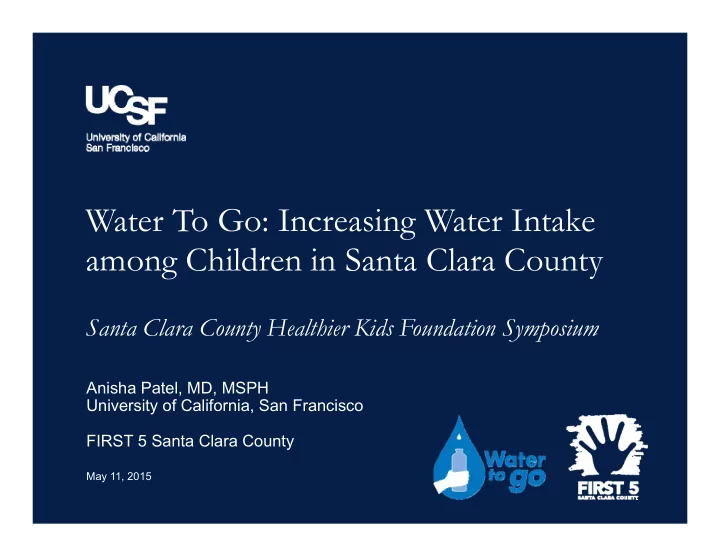

Water To Go: Increasing Water Intake among Children in Santa Clara County Santa Clara County Healthier Kids Foundation Symposium Anisha Patel, MD, MSPH University of California, San Francisco FIRST 5 Santa Clara County May 11, 2015
Presentation Goals Why is water provision and promotion important? Overview of Water To Go Project and evaluation Preliminary results from Water To Go evaluation
Background
Improving Water Intake Among Children is Important Drinking water instead of sugary drinks can prevent obesity and dental caries Being properly hydrated can help children learn Most U.S. children and adolescents do not drink enough water during the day
Many Children May Not Drink from Fountains Fountains are the most common water source Children may not drink from fountains due to concerns about: Tap water safety • Poor water palatability • Improper fountain upkeep • Inadequate access • Lack of cups or water bottles •
Access to Appealing Water Increases Water Intake 100 90 Students Reporting Water Intake 80 70 60 50 49 50 Baseline 39 40 34 34 Follow-up 30 30 at Lunch (%) 20 10 0 Dispenser Cooler Fountains
Water to Go Program
The Water to Go Program Purpose: Water to Go aims to increase access to and utilization of safe, fresh tap water for children and families through the installation and promotion of 100 water bottle filling stations. Water to Go Partners:
Water to Go – Inspired by Legislation California SB1413 • Enacted in September 2010 • Requires all schools in California to provide access to free, fresh drinking water during meal times Healthy, Hunger-Free Kids Act • Enacted in December 2010 • Improves child nutrition policy in many important ways ‒ Includes a provision requiring schools participating in federal meals programs to make free drinking water available with school meals
Water to Go – Selection Criteria FIRST 5 and Santa Clara Valley Water District School Selection Criteria: • Schools with children with body mass index (BMI) scores considered “high risk” • Schools located near pre-school/childcare centers or FIRST 5 Santa Clara County Family Resource Centers • Broad geographic representation Santa Clara County Public Health Site Selection Criteria: • Areas accessible to the public • Fill a need for drinking water access • In an area with high use by children and families
Water to Go School Affiliated Sites SCHOOL DISTRICT SCHOOL SITES Chavez, Arbuckle, Hubbard, Linda Alum Rock Union Vista, Lyndale, Cureton, McEntee/Russo, McCollam Northwood Berryessa Union Sherman Oaks Campbell Union Overfelt, Yerba Buena, Evergreen East Side High School District Valley Dahl, Santee, Kennedy Franklin McKinley Rod Kelley Gilroy Unified Leroy Anderson Moreland El Toro Morgan Hill Unified Theurkauf Mountain View-Whisman
Water to Go – Elementary School Program Installation of hydration stations (reusable water bottle filling stations) in school cafeterias Promotion of stations • “Potter the Otter” signs near stations • Short Sugar Savvy presentation for students/teachers • Potter the Otter play (preschool-3 rd grade) • Potter the Otter books for students to take home (TK-3 rd grade) • Water bottle distribution to students and teachers
Hydration Stations and Signs
Promotional Launch Events
Distribution of Water Bottles
Program Evaluation
Water to Go – School Evaluation Participants: • Water To Go “intervention” schools and matched control schools • Evaluation before and after the program Main outcomes: • Number and function of existing water sources (school water audit) • Student intake of water, SSBs, milk, and juice ‒ Student surveys ‒ Lunchtime observations of student intake ‒ Flowmeter readings from water stations and fountains
Water to Go – School Evaluation Secondary outcomes • Beverage offerings in child care centers near study schools ‒ Child care provider surveys • Teacher and child care provider intake of beverages at school/child care centers ‒ Teacher surveys ‒ Child care provider surveys
Baseline Results
School Characteristics by Intervention Status CHARACTERISTIC INTERVENTION CONTROL (n=10) (n=10) 508.5 537.3 Enrollment (mean) 89% 71% Free and Reduced Price Lunch Eligibility 62% 52% English Language Learners Race/Ethnicity 78% 55% Latino 17% 34% Asian 1% 2% African-American 2% 7% Caucasian 1% 2% Other
Water Access in Evaluation Schools N=20 No Water 5 Fountain 4 Types of Water Sources (n) Jug 4 Station 7 0 5 10 15 20 N=5 schools had no water access
Time to Fill a Water Bottle by Water Source in School Cafeterias Fill Time (seconds) 12 10.9 10 8 6.4 6 4.6 4 2 0 Station Jugs Fountain
Mean Temperature of Cafeteria Water Sources (Fº) Fountain 67.5 Station 59.9 Jug 58
Unappealing Cafeteria Water Access
Provision of Cups 8 of 15 schools with cafeteria water access provided cups 3-4 ounce paper cups Cost covered by food service
Promotional Signage
Students Observed Accessing Free Water in School Cafeterias at Lunch 100 90 80 70 60 50 Students (%) 40 30 20 8 7 10 1 0 Fountains Jugs Stations
Students Observed Accessing Free Water in School Cafeterias at Lunch 100 90 80 70 60 50 Students (%) 40 30 20 10 10 2 0 No Cups Cups
Students Observed Accessing Free Water in School Cafeterias at Lunch 100 90 80 70 60 50 Students (%) 40 30 20 13 7 10 4 0 Stations without Jugs with Cups Stations with Cups Cups
Students Observed Drinking Beverages from Home in Cafeterias at Lunch 10 9 8 7 6 5 4 Students (%) 4 3 2 2 2 1 1 0 Juice Single-Use Reusable Water SSB Water Bottles
Conclusion
Discussion Few students drink water in school cafeterias Installation of stations improves palatability and intake • Improves temperature and water bottle filling time • Leads to an 8-fold increase in the percent of students who drink from cafeteria water sources at lunch Installation of appealing water sources without cups or reusable water bottles may not sufficiently increase intake SSBs are the most common beverages from home
Next Steps Examine Water to Go Program’s impact on: • Intake of water and other beverages among students in child care and elementary schools • Teacher and child care provider intake of water and other beverages
Recommend
More recommend